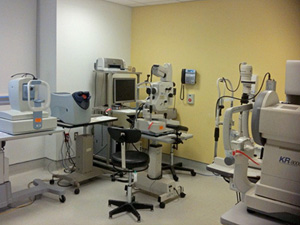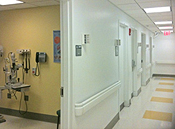Clinical Facilities

Advances at the Affiliates
The centerpiece of the Ophthalmology Department's structural reorganization has been its new emphasis on site-based ophthalmology services, with each site having a local director. In addition to general ophthalmology services, each site now offers a clinic session each week in each subspecialty. Patients with problems that are particularly complex or difficult to diagnose may be referred to an affiliate that is better equipped to deal with that condition. For example, cases demanding the most advanced ocular imaging may be referred to the Bay Ridge Ambulatory Surgery Center; the most complex surgical procedures – such as demanding retinal procedures requiring specialized equipment and dedicated ophthalmology operating room staff – are performed either at Bay Ridge Ambulatory Surgery Center, University Hospital at Downstate or Kings County.
Teaching is conducted at all six major clinical affiliates, with SUNY Downstate residents working with patients at each site under faculty supervision. Residents may rotate among the sites in order to experience a variety of practice environments. Since the patient populations served by the affiliates differ in ethnic makeup, predominant age groups, and socioeconomic status, residents get valuable exposure to the unique range of ophthalmic disorders prevalent in the various groups.

Over the last few years the Ophthalmology Department has worked with leaders at each affiliated institution to improve the local site's facilities and equipment. In return for their investments in the upgrades, the department has pledged an influx of new patients ready to utilize site-based ophthalmology treatment. The result have far exceeded expectations, with patient visits at very high volumes all sites. The following summarizes developments at the six major affiliated programs.
Kings County Hospital Center
Local director, Wayne L. Scott, MD
This major, city-operated hospital – among the largest in the United States – is the center of the Ophthalmology Department's teaching program. With nine ophthalmology residents, it has been a primary focus of faculty and program upgrades since 1996. By mid 1999, every facet of the Kings County ophthalmology program had undergone significant adjustment, including modification of the previous care model.
New equipment, including a new visual field analyzer, Argon and YAG lasers, and a new phacoemulsification unit, has made it possible to perform a far wider range of procedures on site, including state-of-the-art cataract surgery. A new operating room microscope was set up for eye surgery in 2007. An HD Spectral domain OCT for anterior and posterior segment imaging allows clinicians to carefully evaluate a multitude of diseases. An anterior segment digital video camera, a GDX nerve fiber analyzer and a topography unit also are located in the clinic. Currently there is work underway to have all tests available electronically on the network to better serve and mange our patients.
A new clinic space in E building became the home for ophthalmology in the fall of 2006. A state-of-the-art 9,500 square foot clinic area with EMR allows more efficient and patient-friendly appointment scheduling. In addition, a fully-equipped ophthalmic examining room was constructed at the affiliated Susan Smith-McKinney Nursing Home to allow on-site eye care for its residents.
Outpatient visits to the Kings County Ophthalmology Service have increased by a remarkable 59 percent since 1995: from 12,352 to 19,405 total yearly patient visits. The 1998 case mix included 316 surgical procedures. Operating room volume was up 36 percent in 1998. Surgical volume continued to increase with an average of 525 cases now being performed between 2002 and 2005. In 2009 over 750 surgical cases were performed. New for 2010 is a retinal surgical service led by a recent graduate of the program. A new Constellation and new retinal surgical instruments are the beginning of what we believe will be a very busy service.
We have added Oculoplastics faculty beginning in July 2010 along with the new retina attending. We are also in the recruitment phase of a new part time uveitis attending to work with residents in the diagnosis and management of complicated inflammatory diseases of the eye.
University Hospital at Downstate
Local director, Eric Shrier, DO
University Hospital at Downstate, physically part of the SUNY Downstate campus and home to the Ophthalmology Department's administrative and research offices, is a 376-bed hospital that provides a full range of primary, preventive and tertiary care services to central Brooklyn. In a recent change in the residency program curriculum, first-year residents are active participants in the ophthalmology outpatient care and surgery programs at University Hospital, allowing earlier opportunities for surgical exposure.
Since 1996, University Hospital has benefited from a wide range of clinical and administrative area renovations, including modernization of outpatient facilities that began in 1998 and were completed in spring 1999. The state-of-the-art equipment added has made University Hospital outstanding among facilities in Brooklyn – with physicians practicing there now capable of performing an exhaustive range of therapeutic testing. Improvements to the hospital's main operating rooms allowed the number of ophthalmic procedures conducted there to grow from an average of five cases yearly to 500 procedures performed in 1999. We currently in 2009 perform over 800 cases annually. Our outpatient facility was moved to 2171 Nostrand Avenue in 2005 and this has again led to an increase in our outpatient volume. This space is larger than our previous area and is very accessible to patients from all over the borough. We offer both comprehensive and specialty care in this modern facility.
Brooklyn Veterans Admistration Hospital
Harbor Health Care Systems, Brooklyn Campus
Local director, Edward Smith, MD
The Brooklyn Veterans Administration Hospital has been affiliated with SUNY Downstate since 1975. Following the Brooklyn VA and Manhattan VA hospital merger in January 1999, this institution continued its affiliation with SUNY Downstate under the new name of Department of Veteran Affairs New York Harbor Health Care Systems, Brooklyn Campus. Currently, three SUNY Downstate ophthalmology residents are among the 118 residents-in-training at the 1,000-bed VA facility. They work with patients under the supervision of seven faculty physicians – an equivalent of 2.6 full-time Ophthalmology Department faculty. Clinics in all six departmental subspecialties are offered. The patient population is made up primarily of geriatric veterans and some prisoners. The most common disorders encountered include cataracts, glaucoma, diabetic retinopathy and other retina problems. The facility averages 900 clinic visits monthly, and performs approximately 300 surgical procedures annually.
Recent developments in services at the VA have included the opening of a new, combined ophthalmology/optometry outpatient department in September 1998, which is under the direction of Edward Smith, MD, associate chief of ophthalmology.
Coney Island Hospital
Local Director, Anthony Girardi, MD
Coney Island Hospital is a member of the City of New York's Health and Hospitals Corporation. The facility is the largest employer in South Brooklyn and is the major medical resource for the diverse populations that live and work there. The ophthalmology service offers comprehensive eye care as well as a full complement of subspecialty care, including both inpatient and outpatient services. Over the past several years, the clinic and operating room facilities have been upgraded and now include state-of-the-art diagnostic and treatment equipment rivaling those at any major medical center. Physicians are now able to take advantage of improved fundus and anterior segment photography capability and Argon and YAG laser capability, as well as improved refractive and diagnostic examining lanes. Computerized laboratory and radiology retrieval systems are now in place, and plans for a completely computerized medical record system are being refined. Recent acquisitions for the operating room have included two new phacoemulsification units with both anterior and posterior capability as well as complete microsurgical instrument sets. The most advanced cataract and glaucoma procedures can now be performed on site.
The ophthalmology service at Coney Island Hospital has been under the direction of Dr. Girardi since 2004. Currently there are seven faculty members representing all of the major ophthalmologic subspecialties. Three SUNY-Downstate residents rotate through the service at any time, along with residents rotating from the Departments of Medicine and Family Practice. The population of patients seen at Coney Island Hospital is unique in that it consists almost entirely of recent immigrants from the former Soviet Union and the present Eastern European republics. These patients present with a variety of disorders including a high proportion of age-related macular degeneration, pseudoexfoliation glaucoma, cataracts and diabetic retinopathy.
While the demographics of the South Brooklyn area are changing, the ophthalmology service continues to enjoy high volumes both in the outpatient service and in surgical procedures performed. In 1998, almost 13,000 patients were treated by the ophthalmology staff and over 200 procedures were performed, an increase of 6 percent over the past two years. This volume has remained stable through 2010 and residents always enjoy the learning experience at this busy HHC facility.